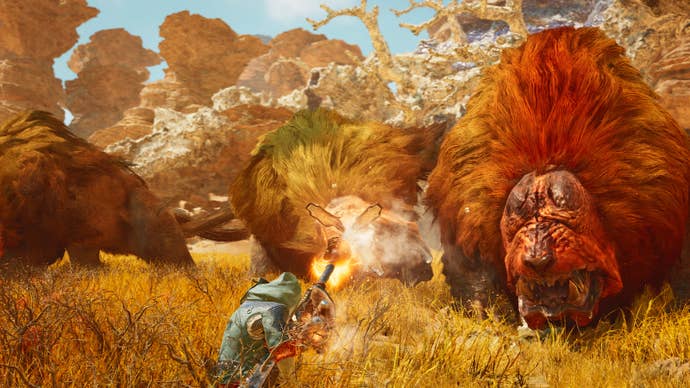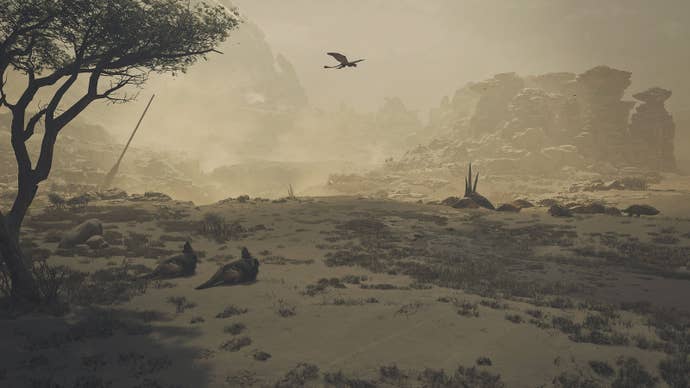Do you fancy more Monster Hunter World? Like, a lot more? If the answer is yes – which it very much should be – Monster Hunter Wilds has you covered.
When you’re talking sequels, ‘more of the same’ can really run the gamut. It can be a pejorative, a suggestion that a developer hasn’t changed or done enough, guilty of taking the easy path with a sequel. But it can also be an expression of joy at a developer bloody well going for it, building on what came before in a way that is iterative, but also quietly revelatory. Having seen a half-hour demonstration of an exhilarating new hunt, Monster Hunter Wilds looks like the latter.
In some sense, this is my favourite sort of sequel. There’s not much point in me covering the basic concepts of the game, nor its broad structure – all of this remains unchanged from Monster Hunter World. If you haven’t played that game, you should – it’s nice and cheap now, and it’s worth every penny.. At a glance, in those first stages of its demo, you could even mistake Wilds for some sort of souped-up, max-settings version of World. “Sure looks like more MH,” I find I’ve scribbled in my notebook. But then, as the mission begins, a suite of exciting changes and additions is slowly revealed, one after another. Very quickly, it goes from feeling like more of the same to an epic evolution on what came before.
If I had to sum up what I saw in the demo in short, I’d narrow it down to two key elements of Wilds: first of all, it’s enormous. Massive. Capcom reps say that the maps are around twice the size of the previous game, which is part of why mounts are now a major part of the experience. When I ask the developers if the mounts were picked up directly from the Switch-focused Monster Hunter Rise, they push back – the strands of Monster Hunter are developed in parallel but separately, and the Wilds developers reached the conclusion that a mount was necessary organically due to the sheer size of what they were building. Certainly, even in thirty minutes, I’m left astonished by the scale on offer.
The second element is a continuation of the magic x-factor that arguably made Monster Hunter World so special – its status as a seamless, emergent, and deeply interactive experience. Wilds appears more dedicated to this than ever – something that I think is best represented in a core change to the base camp. Traditionally, the base camp has been a discrete zone you head to via a loading screen, the place where you pick up missions, upgrade, chat up NPCs, and party up with friends. All of this is still the case – but there’s one key difference.

In Wilds, the base camp is now a seamless part of the huge sprawling Windward Plains zone that the demo takes place in. Other zones will have their own base camps, too. In any case, you simply walk from the camp out into the titular Wilds. Danger could lurk right by the entrance to camp; it makes the whole experience feel a lot more joined-up.
Leaving the base camp, we see developers from Japan take on the contract to take down an Alpha Doshaguma, a beast that at first is amidst a pack of its slightly lesser but still rather enormous peers. That makes the opening to the hunt tough – but also a perfect demonstration of Monster Hunter’s emergent madness. The player gets stuck in, landing a few sneak attack hits on the Alpha in order to formally trigger the hunt as started. But as soon as they do that, the pack of Doshaguma goes wild – all attacking at once.
Cue clever use of those open, wide-ranging open zones that Wilds is so hugely expanding. With a whistle the Seikret mount is summoned in order to flee the now furious beasts. I love how this looks, with the hunter not stopping in his flight from the monsters as the mount approaches. With one of those animations that’s so effortlessly cool that few will even notice its brilliance the hunter jumps, mid-run, to land on the Seikret – and now the chase is on. There’s firing giant guns from the mount’s back to retain aggro and deal damage as the Doshaguma give chase, weaving around the map in an attempt to draw the Alpha away from its pack to make it an easier target.

I love demos like this. They’re live, and they go wrong. That means not all developers are willing to do them, but Capcom has embraced the chaos. The reason for that is simple: a key pillar of this game and its predecessor is the idea of these Monster Hunter zones as living, breathing worlds – as ecosystems with a food chain. In a way, a good Monster Hunter map has a little in common with a great Hitman level – it’s a sort of rube goldberg machine of actors and world design elements that interact alone, but once there’s even the smallest player input everything can go flying off in weird and wonderful directions.
Like I say, you get that sense in this demo. At one point, they clearly want to show off an environmental trap where loose boulders on the ceiling can be dropped onto foes. But the Doshaguma won’t stand under the hazard, obviously, and the developers keep missing. In another moment, the ‘alpha’ monster of the area sweeps in and was presumably meant to get into a tangle with our target, but ends up distracted by something else. The demo rolls on. It’s great. This chaos, and adapting to it, is what makes Monster Hunter special. You plan and plan, crafting the perfect gear and building a strategy – and then, inevitably, you are forced to adapt.
A new wrinkle in this is weather, which appears to be a major pillar in terms of how Wilds will build on World. Midway through this hunt a sandstorm sweeps in, impacting visibility and also drastically affecting the world itself. The monsters and endemic life willing to venture out into the world differs depending on what the world is like at any given moment – so as the skies darken and the sandstorm takes hold, some monsters will go to ground and others will emerge, emboldened.

All of this means there’s a lot going on, but Wilds seems well-primed to ease players through that, too. Palico speak now, and often chime in with warnings and suggestions in order to help players keep track of everything going on. The map has seen huge leaps forwards, and is just rammed with a level of information and granularity that should be a hardcore hunter’s dream. UI elements have been adjusted to make it clearer if a Monster is actively targeting you – and so on and so forth. The upgrades seem innumerable, and fans will likely spend much of the run up to launch deciphering them.
The end result is a game that looks brilliant, anyway. It looks like exactly what I wanted as a follow-up to World. While the formula is set, and Capcom certainly doesn’t need to reinvent the wheel, Monster Hunter Wilds is clearly still filled with the same bonkers ambition and boundless energy that made World great. Just because they made Capcom’s best-selling game ever, the team hasn’t rested on their laurels: if anything, it’s made them more ambitious. I can’t wait to see what else they have in store.
Monster Hunter Wilds is set to release in 2025 on PC, PS5, and Xbox Series X/S.

